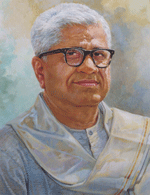The country’s premier and perhaps only university town, Manipal (pop.28,000) is India’s answer to the university towns of the American Mid West and Britain’s Oxbridge. Though Manipal with its utilitarian PWD-style buildings lacks the defining architecture which distinguishes and characterises Britain’s ancient university towns, there is no denying that it is perhaps India’s only (another contender: Pilani in Rajasthan which hosts the Birla Institute of Technology) student town. Against the native town population estimated at 10,000, Manipal with its 19 institutions of higher learning spread over the town boasts a gown (students and faculty) population of over 18,000.
 Behind the miraculous metamorphosis of this former village situated atop a plateau overlooking the blue Arabian Sea some 60 miles to the west and the blue Western Ghats to the east, into a university town which could one day restore the glory of the ancient Indian university towns of Taxila and Pataliputra to a nation fallen on hard times, is the remarkable story of the Pai family and the late Dr. Tonse Madhava Anantha (T.M.A.) Pai (1898-1979) in particular. Driven by a spirit of enlightened self-interest and understanding of development economics, almost a century before Dr. Amartya Sen was awarded the 1999 economics Nobel Prize for highlighting the critical linkage between education and economic development, TMA Pai transformed this sleepy village a few miles from his native temple town of Udupi into a university town which is attracting notices from around the world.
Behind the miraculous metamorphosis of this former village situated atop a plateau overlooking the blue Arabian Sea some 60 miles to the west and the blue Western Ghats to the east, into a university town which could one day restore the glory of the ancient Indian university towns of Taxila and Pataliputra to a nation fallen on hard times, is the remarkable story of the Pai family and the late Dr. Tonse Madhava Anantha (T.M.A.) Pai (1898-1979) in particular. Driven by a spirit of enlightened self-interest and understanding of development economics, almost a century before Dr. Amartya Sen was awarded the 1999 economics Nobel Prize for highlighting the critical linkage between education and economic development, TMA Pai transformed this sleepy village a few miles from his native temple town of Udupi into a university town which is attracting notices from around the world.
“How did it happen that in the context of a quiet Indian village, an ordinary Hindu family of modest means produced a generation that suddenly emerged as successful innovators in business and education? What combination of factors had motivated this break with the past, in which one family overcame the dead weight of rigid customs and an entrenched government bureaucracy to accomplish so much for the people of their area? If these questions could be answered, the results could have profound implications for the future of democracy in India and other developing countries,” wrote Selden Menefee a former Washington Post and Christian Science Monitor journalist and educationist in the foreword to his engrossing book The Pais of Manipal, first published in 1967 and revised and reprinted in 1984.
Though those who want a detailed answer to this question posed by Menefee, will need to read his painstakingly researched book. For the purpose of this feature it would be sufficient to emphasise that the Pai family of Kallianpur near Udupi, could be classified as middle class only by rock bottom Indian standards. T.M.A. (Madhava) Pai, the third son of Anantha and Yashoda Pai was born on April 30, 1898 in a joint family home shared by over 50 people who also farmed 20 acres of rice paddy land owned by the family. In 1905 when Madhava Pai’s grandfather died, his father Anantha did not inherit any land — only a bequest of Rs.200. Three years after Anantha Pai died at the young age of 39, this modest bequest which supported Madhava, his three brothers and a sister, was exhausted.
Despite these and other tribulations, recounted in poignant detail by Menefee in his book, Anantha Pai’s sons stuck together, helping each other with the elder ones financing Madhava’s secondary and astonishingly frugal medical education in Madras. In 1925 TMA Pai graduated and was awarded his MBBS degree by the Madras Medical College. In that very year with the help of his brothers and by selling his wife’s jewellery to import some medical equipment from Germany, young Madhava inaugurated Udupi’s first nursing home.
Meanwhile in the very same year (1925) TMA’s brother Upendra Pai promoted the Canara Industrial and Syndicate Bank (later known as Syndicate Bank) in a single room adjoining the hardware store of TMA’s eldest brother P.A. Pai, with a paid up capital of Rs.8,000 to help “cottage industries such as weaving and spinning by supplying yarn and cotton at a moderate price”.
The Syndicate Bank and TMA’s nursing home next door became the nucleus of the Manipal Education and Medical Group (MEMG) which today consists of 55 institutions of learning including two teaching hospitals, two dental colleges, several engineering colleges and postgraduate institutions of management, communication and hotel management in Manipal, and further afield in Sikkim, Nepal, Malaysia and Antigua.